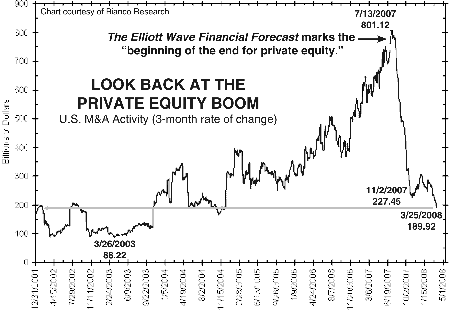BREAKING NEWS
March 31, 2008
Private Equity: Nothing More Than Clumsy Trick
So now we know. The boom in private equity, which was promoted as the superior business model, based on patient capital, superior management and an alignment of interests, was nothing more than a trick of financial engineering – and a clumsy one at that. The magic of leverage works both ways, as we are discovering.
As investors are increasingly bruised by the recognition that reality has once again triumphed over hope, the private equity barons are having to confess that the benefits of superior management, alignment of interest and, of course, the superior reward structure counted for very little.
Many of the private equity deals look no different from Yell and other highly leveraged public companies. Sometimes a simple observation can prove an important point. In November 2006 Citibank published a research report that highlighted how private equity returns could be achieved by just leveraging basic stock market indices. It is a seminal note. “How do they do that?” asked the report, and then went on to provide the answer.
By leveraging the basic stock market indices by three to one, Citibank pointed out, returns could exceed even the best historical private equity returns. Never mind that as they were spellchecking the final version of the note, leverage on that season’s deals was reaching four to one and even five or six to one.
As Citibank pointed out, the private equity barons would always emphasise alpha over beta – their ability to outperform a market rather than merely ride the market wave – but it showed clearly that leveraged beta was where the returns were being generated.
Private equity as we have come to know it is all about debt – lock, stock and sinking barrel. There may have been better management and better incentive structures in the deals of recent years. But they really contribute nothing to the overall return when compared with the impact of the leverage in the capital structure.
Financial Times |
| June 2008 |
| S |
M |
T |
W |
T |
F |
S |
|
1
|
2
|
3
|
4
|
5
|
6
|
7
|
|
8
|
9
|
10
|
11
|
12
|
13
|
14
|
|
15
|
16
|
17
|
18
|
19
|
20
|
21
|
|
22
|
23
|
24
|
25
|
26
|
27
|
28
|
|
29
|
30
|
|
|
|
|
|
|
|
 |
|
« Previous |
Main Page
| Next »
|
Reality of Private Equity Has Only Just Begun to Appear
By: Pete Kendall, April 2, 2008 |
The very latest headlines from the private equity sector mark the beginning of the end for private equity: ‘Dark Side to Leverage’ Slows Buyouts” (USAToday, June 28, 2007), “Market’s Jitters Stir Some Fears For Buyout Boom” (WSJ, June 28, 2007) and “Private Equity Faces Investor Revolt” (Financial Times, June 27, 2007).
The Elliott Wave Financial Forecast, July 2007 |

Here again, we were a little early. EWFF first discussed the private equity phenomenon in late 2006. But one of the things we stated was that the while private equity was the type of activity that tends to extend a long advance, it would be particularly onerous on companies that employ it. The reason is that it saddles firms with burdensome debts at a time when cash is getting extremely hard to come by.
“Instead of reducing their exposure to debt companies and individuals are increasing it,” said the December 2006 EWFF. “Buyers are financing the deals with private equity in which 70% of the purchase price is bank debt that is held on the balance sheet of the purchased company. According to Standard & Poor’s, corporations have also significantly increased their use of debt financing in acquisitions. ‘There has been a fundamental shift in companies’ attitude towards debt as shareholders have put more pressure on them to perform,’ says Standard & Poor. The more vulnerable the economy and markets get, the more precariously companies and individuals position themselves.”
So, a mountain of debt created by the upward surge of mergers and acquisitions (shown on the chart above) is not growing anymore, but it’s just starting to drag down many a balance sheet. The last chapter in the private equity sage will show the full extent of the burden created by these deals. It will become visible as deflation sets in and companies find it harder and harder to generate cash flow. In the end, there will probably be a very public backlash against private equity. This will appear as the economic contraction tightens its grip.
|
|
Post a comment
|
|
|
 |
| RECENT ARTICLES |
 |
June 13, 2008
SocioTimes Page Closes, But Updates Continue
read more |
June 4, 2008
Over the Top: SUV Plunge Marks New Bear Phase; For SocioTimes It's Just Over
read more |
June 3, 2008
Mastercard Taps Into Credit Angst With Mr. Bill Comeback
read more |
May 9, 2008
From Rust to Dust: Reversal Lands On 11th Ave. Development
read more |
April 2, 2008
Reality of Private Equity Has Only Just Begun to Appear
read more |
|
|
| ARTICLE COMMENTS |
 |
|
|
|
|
